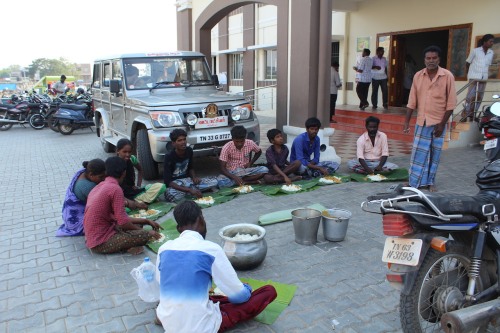
The rescued bonded labourers are provided food by the Taluk office in Erode District, Tamil Nadu
In January 2016, NASC visited various worksites in Erode district, covering over 90 different brick-kiln units and helped the government identify around 12 brick-kilns with bonded labourers.
15 of these labourers are inter-district migrant bonded labourers who lost their livelihoods due to the Tsunami that hit Tamil Nadu in 2004. They were then recruited by an agent who transported them across districts to work as bonded labourers in brick kilns.
Soon after the Tsunami, these labourers obtained a loan of Rs.20,000. That amount has now matured to an advance of around Rs.1 Lakh per family. These families were denied minimum wages and were only paid around Rs.200 a week, despite being made to work for 6 days a week. They were also denied their constitutional freedoms of employment and movement. The labourers recounted to NASC how they were prohibited from leaving the facility unless they left a family member behind as ‘Jameen’ (a slave / wager) until they returned. Moreover, children were not allowed to attend school and were subjected to physical and verbal abuse. Additionally, NASC also observed evidence of violence against the bonded labourers, who were often considered and treated as untouchables by the factory owner.
In NASC’s legal opinion, the owner of this brick kiln can be found in violation of laws such as the Bonded Labour System Abolition Act 1976, Child Labour (Prohibition & Regulation) Act 1986, Scheduled Castes & Scheduled Tribes Prevention of Atrocities Act 1989, Indian Penal Code (IPC) Sec.370, Right to Education 2009 and others. Evidence of the same has been thoroughly documented by us.
The District Magistrate initiated the release and rescue process in early February. The Sub Divisional Magistrate was very cooperative and supportive and started the enquiry process. He brought the 15 identified bonded labours to the Taluk office and provided food, accommodation and protection. By then, this story had also received significant coverage by local media. The Sub-Collector (SDM) along with his team Tahsildar, Revenue Inspector, Village Administrative Officers, proceeded to conduct a detailed enquiry. It was discovered that none of these brick-kilns followed any procedures as stipulated by the National Human Rights Commission (NHRC), i.e. little to no workers records, registration records, wage payment, etc.
The SDM and Tahsildar started giving food, protection, accommodation to the rescued bonded labourers and information was given to the District Social Welfare Department, Child Labour Eradication Department and Police department. While the SDM was very supportive in providing as much rehab support possible, he was unable to grant release certificates.
While we at NASC are grateful to the SDM and the local government for their support with the short term rehab needs of the rescued survivors, it is imperative to have more long-term rehab solutions in place. For this, it is vital for the rescued survivors of bonded labour to be granted their release certificates. While NASC is currently working on the legal and rehab elements of this case, we’re hopeful that the Erode district local government grants the release certificates to these survivors who have just been rescued from a harrowing decade of captivity in bonded labour.
*This Bandhua story was contributed by the National Adivasi Solidarity Council (NASC)


